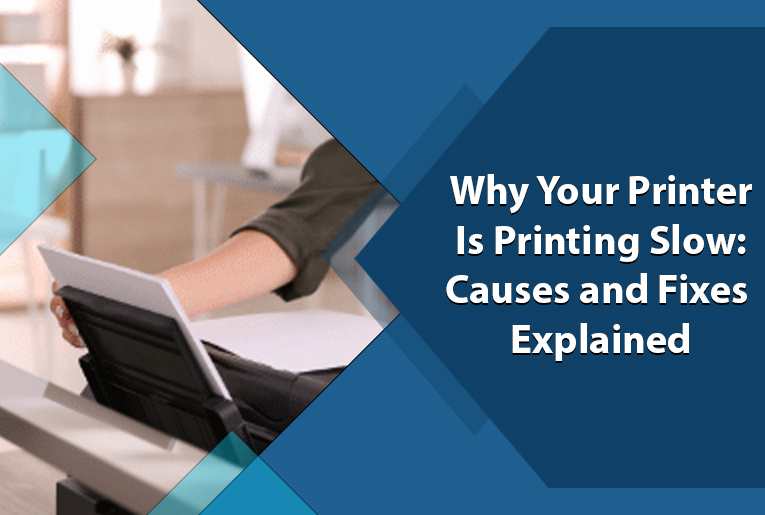Have you ever waited for a document to print and noticed your printer printing slow? You are not alone. Slow printing can be frustrating, especially when you have tight deadlines or multiple documents to print. But why does it happen? And more importantly, how to speed up printer printing to avoid unnecessary delays? In this blog, we’ll explore the common causes of slow printing and provide practical fixes to get your printer back to full speed.
Common Causes of Printer Printing Slow
There are several reasons why your printer may be printing slow. Let’s break down some of the most common culprits:
1. High Print Quality Settings
The most common cause of printers printing slowly is the quality setting for printing. When a printer is set to print at the highest quality possible for better image or text clarity, then the printout takes longer in the printing process. This becomes more visible when printing images or high-quality documents.
If you don’t need quality prints, set the quality settings to lower for the sake of increasing the speed of printing. You can change this through your printer’s settings menu in the print dialog or through your printer’s control panel.
2. Outdated Printer Drivers
If your printer’s drivers are outdated or do not support your computer’s OS, it will result in slow printing. The driver may be outdated and does not communicate with the printer efficiently, thus slowing it down.
Fix: Update your printer drivers. Visit the manufacturer’s website and download the updated drivers for your printer model. Updating drivers will make communication between your computer and the printer efficient, thus making it faster.
3. Network or Connectivity Issues
Poor Wi-Fi signal or poor connectivity causes network printers to take much longer to print. For example, if the printer is wireless, a weak or unstable signal between the computer and the printer causes data transfer to take a much longer time.
Fix: Make sure your printer is within the range of the Wi-Fi router. If available, use an Ethernet connection since it is faster for data transfer. Alternatively, restart the router and the printer to try to reset the connection, then check for software updates.
4. Too Many Print Jobs in the Queue
If there are multiple print jobs in the queue or if a big document is waiting to be printed, your printer will become overworked, leading to a delay in processing and printing. This is one of the common causes of the printer printing slow.
Fix: Look at your print queue and cancel those unnecessary or stalled print jobs. Remove the queue regularly to ensure your printer is not bogged down with pending tasks. This can be done through the print queue window in your computer’s printer settings.
5. Out of Date or Faulty Firmware
Just like printer drivers, obsolete firmware slows down the printer. Firmware updates from printer manufacturers are usually made to improve functionality and fix bugs that could have an impact on the printing speed.
Fix: Check the manufacturer’s website for any available firmware updates for your printer. Firmware updates can often improve the speed of printing and efficiency.
6. Insufficient Printer Memory
Printers do have a memory, though, which they use to process and store print jobs. Therefore, if the print job is large or complicated, it may take more time to be processed by the printer. Older machines may also possess less memory; this can be a result in slower speeds of printing.
This includes upgrading the memory of the printer if that is possible because additional memory may speed up how the printer processes jobs. Alternatively, try printing on smaller documents or breaking jobs into smaller print commands and printing in batches.
7. Low Ink or Toner Levels
When the ink or toner levels in your printer are low, it may slow up your printer. Some slow printers avoid damaging their components while others run out of ink, meaning there is not enough to print quickly.
Fix: Check on the ink or toner levels in your printer and replace the cartridge. Only use original printer cartridges for the best print quality and performance.
How to Speed Up Printer Printing: General Tips
If you’re wondering how to speed up printer printing, here are some general tips that can help improve the overall performance of your printer:
- Use a Faster Printer: If your printer is older or designed for light use, upgrading to a faster model may be the best solution. Laser printers, for example, typically print faster than inkjet printers, especially when printing multiple pages.
- Print in Draft Mode: If print quality does not matter, print in draft mode so that it will print faster. This saves the ink used and accelerates the printing process.
- Print Resolution: For text documents other than images, the print resolution can be lowered to hasten the printing process. In daily texts, high resolutions are not necessary.
- Organize Your Print Queue: Regularly clean out your print queue to prevent delays. If there are stuck or outdated print jobs, cancel them and restart your printing tasks.
- Upgrade to a USB Connection: If you’re printing over a network and experiencing slow speeds, try switching to a USB connection, which typically offers faster transfer speeds compared to wireless connections.

